Schedule E
List income, war profits, and excess profits taxes paid or accrued
to the United States and to any foreign country or U.S. possession for
the annual accounting period. Report these amounts in column (b) in
the local currency in which the taxes are payable. Translate these
amounts into U.S. dollars at the average exchange rate for the tax
year to which the tax relates. See section 986(a). Identify the
exchange rate used in column (c) and report the translated dollar
amount in column (d).
Schedule F
If the foreign corporation uses DASTM, the tax balance sheet on
Schedule F should be prepared and translated into U.S. dollars
according to Regulations section 1.985-3(d), rather than U.S. GAAP.
Schedule G
Question 1
If the foreign corporation owns at least a 10% interest, directly
or indirectly, in any foreign partnership (other than any partnership
for which a Form 8865 was filed), attach a statement listing the
following information for each foreign partnership.
- Name and EIN (if any), of the foreign partnership;
- Identify which, if any, of the following forms the foreign
partnership filed for its tax year ending with or within the
corporation's tax year: Form 1042, 1065 or 1065-B, or 8804;
- Name of the tax matters partner (if any); and
- Beginning and ending dates of the foreign partnership's tax
year.
Schedule H
Use Schedule H to report the foreign corporation's current E&P
figured in functional currency for U.S. tax purposes.
Special rules for DASTM.
If the foreign corporation uses DASTM, enter on line 1 the dollar
GAAP income or (loss) from line 21 of Schedule C, and use Schedule H
to reflect adjustments made in figuring income or loss in dollars for
tax purposes. DASTM gain or loss figured under Regulations section
1.985-3(d) should be reported on line 5b.
Lines 2a through 2h.
Certain adjustments (required by Regulations sections 1.964-1(b)
and (c)) must be made to the foreign corporation's line 1 net book
income or (loss) to determine its E&P. These adjustments may
include both positive and negative adjustments to conform the foreign
book income to U.S. GAAP and to U.S. tax accounting principles. If the
foreign corporation's books are maintained in functional currency in
accordance with U.S. GAAP, enter on line 1 the functional currency
GAAP income or (loss) from line 21 of Schedule C, rather than starting
with foreign book income, and show GAAP-to-tax adjustments on lines 2a
through 2h.
Lines 2b and 2c.
Generally, depreciation, depletion, and amortization allowances
must be based on the historical cost of the underlying asset, and
depreciation must be figured according to section 167 (or, if 20% or
more of the foreign corporation's gross income is from U.S. sources,
on a straight line basis according to Regulations section 1.312-15).
Line 2f.
Inventories must be taken into account according to the rules of
sections 471 (incorporating the provisions of section 263A) and 472
and the related regulations.
Line 2g.
See the instructions for Schedule C, line 20.
Line 2h.
Enter the net amount of any additional adjustments not included on
lines 2a through 2g. List these additional adjustments on a separate
schedule. Attach this schedule to Form 5471.
Line 5b.
DASTM gain or (loss), reflecting unrealized exchange gain or loss,
should be entered on line 5b only for foreign corporations that use
DASTM.
Line 5d.
Enter the line 5c functional currency amount translated into U.S.
dollars at the average exchange rate for the foreign corporation's tax
year. See section 989(b). Specify the exchange rate used. If the
foreign corporation uses DASTM, enter on line 5d the same amount
entered on line 5c.
Blocked income.
The E&P of the foreign corporation, as reflected on Schedule H,
must not be reduced by all or any part of such E&P that could not
have been distributed by the foreign corporation due to currency or
other restrictions or limitations imposed under the laws of any
foreign country.
Schedule I
Use Schedule I to report in U.S. dollars the U.S. shareholder's pro
rata share of income from the foreign corporation reportable under
subpart F and other income realized from a corporate distribution.
Line 1
Subpart F income.
Generally, the income of a foreign corporation with U.S.
shareholders is not taxed to those U.S. shareholders until the income
is repatriated to the United States (e.g., through the payment of
dividends to the U.S. shareholders or in the form of gain on the
disposition of the U.S. shareholders' stock in the foreign
corporation). However, this deferral of U.S. tax is not available to
U.S. shareholders of CFCs with certain types of income, including
subpart F income. For more information, see sections 951 and 952.
Use Worksheet A (which begins on page 7) to compute the U.S.
shareholder's pro rata share of subpart F income of the CFC. Subpart F
income includes the following:
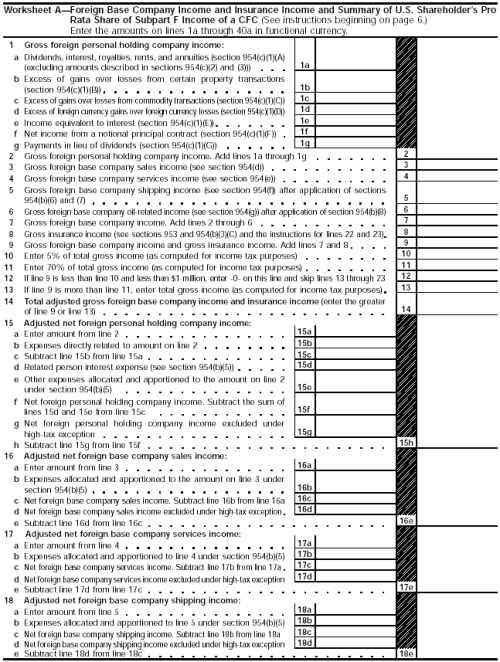
Worksheet
A
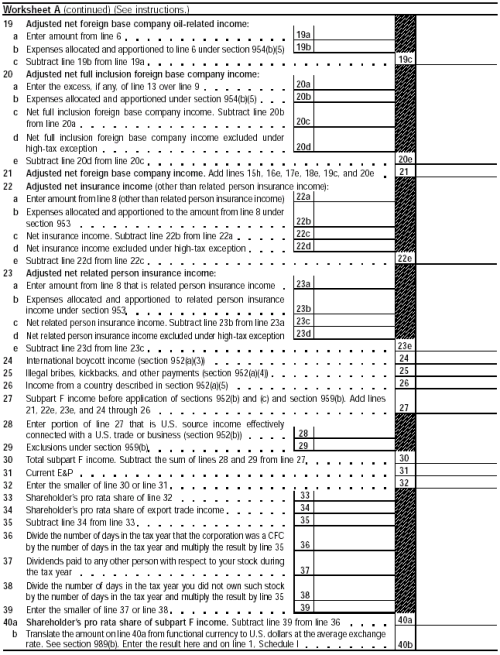
Worksheet
A (continued)
- Adjusted net foreign base company income (lines 1 through
21);
- Adjusted net insurance income (line 22);
- Adjusted net related person insurance income (line
23);
- International boycott income (line 24);
- Illegal bribes, kickbacks, and other payments (line 25);
and
- Income from a country described in section 952(a)(5) (line
26).
Important:
If the subpart F income of any CFC for any tax year was reduced
because of the current E&P limitation (see the instructions for
line 31 of Worksheet A on page 10), any excess of the E&P of the
CFC for any subsequent tax year over the subpart F income of the CFC
for the tax year must be recharacterized as subpart F income.
Lines 2 Through 4
Other amounts not eligible for deferral that are reported on
Schedule I include:
- Earnings invested in U.S. property (Worksheet B);
- Amounts withdrawn from qualified investments in less
developed countries and amounts withdrawn from qualified investments
in foreign base company shipping operations (Worksheet C); and
- Amounts withdrawn from investment in export trade assets
(Worksheet D).
Line 5
Enter the factoring income (as defined in section 864(d)(1)) if no
subpart F income is reported on line 1a, Worksheet A, because of the
operation of the de minimis rule (see lines 1a, 10, and 12 of
Worksheet A and the related instructions).
Line 6
Add lines 1 through 5. Enter the result here and on your income tax
return. For a corporate U.S. shareholder, enter the result on Schedule
C, Form 1120, or on the comparable line of other corporate income tax
returns. For a noncorporate U.S. shareholder, enter the result on
Schedule B, Form 1040, or on the comparable line of other noncorporate
income tax returns.
Line 7
Enter the dividends you received from the foreign corporation that
were not previously taxed under subpart F in the current year or in
any prior year.
Line 8
If previously taxed E&P described in section 959(a) or (b) was
distributed, enter the amount of foreign currency gain or (loss) on
the distribution, computed under section 986(c). See Notice 88-71,
1988-2 C.B. 374, for rules for computing section 986(c) gain or
(loss).
For a corporate U.S. shareholder, include the gain or (loss) as
other income on Form 1120, or on the comparable line of other
corporate income tax returns. For a noncorporate U.S. shareholder,
include the result as other income on Form 1040, or on the
comparable line of other noncorporate income tax returns.
Worksheet A
Important:
For tax years beginning after December 31, 1998, and before January
1, 2002, the following exceptions apply.
- Foreign personal holding company income generally shall not
include income derived in the active conduct of a CFC of a banking,
finance, or similar business (section 954(h)).
- Foreign personal holding company and insurance income shall
not include certain investment income derived by a qualifying
insurance company and by certain qualifying insurance branches
(sections 953(a)(2) and 954(i)).
- Foreign base company services income shall not include
income that is exempt insurance income under section 953(e) or that is
not treated as foreign personal holding company income under the
active conduct of an insurance business exception (section 954(i));
the active conduct of a banking, financing, or similar business
exception (section 954(h)); or the securities dealer exception
(section 954(c)(2)(C)(ii)).
Line 1a.
Do not include the following:
- Interest from conducting a banking business that is
export financing interest (section 904(d)(2)(G));
- Rents and royalties from actively conducting a trade or
business received from a person other than a related person
(section 954(d)(3)); and
- Dividends, interest, rent or royalty income from related
corporate payors described in section 954(c)(3). However, see section
964(e) for an exception.
Interest income includes factoring income arising when a person
acquires a trade or service receivable (directly or indirectly) from a
related person. The income is treated as interest on a loan to the
obligor under section 864(d)(1) and is generally not eligible for the
de minimis, export financing, and related party exceptions to the
inclusion of subpart F income. Also, a trade or service receivable
acquired or treated as acquired by a CFC from a related U.S. person is
considered an investment in U.S. property for purposes of section 956
(Worksheet B) if the obligor is a U.S. person.
Line 1b.
Enter the excess of gains over losses from the sale or exchange of:
- Property that produces the type of income reportable on line
1a.
Note:
For tax years beginning after December 31, 1998, and before January
1, 2002, see section 954(c)(1)(B)(i).
- An interest in a trust, partnership, or REMIC.
- Property that does not produce any income.
Do not include:
- Income, gain, deduction, or loss from any transaction
(including a hedging transaction) of a regular dealer in property,
forward contracts, option contracts, and similar financial instruments
(section 954(c)(2)(C)).
- Gains and losses from the sale or exchange of any property
that, in the hands of the CFC, is property described in section
1221(1).
Line 1c.
Enter the excess of gains over losses from transactions (including
futures, forward, and similar transactions) in any commodities. See
section 954(c)(1)(C) for exceptions.
Line 1d.
Enter the excess of foreign currency gains over foreign currency
losses from section 988 transactions. An exception applies to
transactions directly related to the business needs of a CFC.
Line 1e.
Enter any income equivalent to interest, including income from
commitment fees (or similar amounts) for loans actually made.
Line 1f.
Include net income from notional principal contracts (except a
contract entered into to hedge inventory property).
Line 1g.
Include payments in lieu of dividends that are made as required
under section 1058.
Line 12. De minimis rule.
If the sum of foreign base company income (determined without
regard to the deductions of section 954(b)(5) and gross insurance
income (as defined in section 954(b)(3)(C)) for the tax year is
less than the smaller of 5% of gross income for income tax
purposes, or $1 million, then no portion of the gross income for the
tax year is treated as foreign base company income or insurance
income. In this case, enter zero on line 12 and skip lines 13 through
23. Otherwise, go to line 13.
Line 13. Full inclusion rule.
If the sum of foreign base company income (determined without
regard to the deduction of section 954(b)(5)) and insurance income for
the tax year exceeds 70% of gross income for income tax purposes, the
entire gross income for the tax year must (subject to the high tax
exception described below, the section 952(b) exclusion, and the
deductions to be taken into account under section 954(b)(5)), be
treated as foreign base company income or insurance income (whichever
is appropriate). In this case, enter total gross income (for income
tax purposes) on line 13. Otherwise, enter zero.
Lines 15g, 16d, 17d, 18d, 20d, 22d, and 23d. Exception for certain income subject to high foreign taxes.
Foreign base company income and insurance income does not include
any item of income received by a CFC if the taxpayer establishes that
such income was subject to an effective rate of income tax imposed by
a foreign country that is greater than 90% of the maximum rate of tax
specified in section 11. This rule does not apply to foreign base
company oil-related income. For more information, see section
954(a)(5) and Regulations section 1.954-1(d)(1).
Line 22. Adjusted net insurance income.
In determining a shareholder's pro rata share of the subpart F
income of a CFC, insurance income is any income:
- That is attributable to the issuing (or reinsuring) of any
insurance or annuity contract:
- For property in, liability from an activity in, or for the
lives or health of residents of a country other than the country under
the laws of which the CFC is created or organized or
- For risks not described in 1 above, resulting
from any arrangement in which another corporation receives a
substantially equal amount of premiums or other consideration for
issuing (or reinsuring) a contract described in 1
above.
- That would (subject to the modifications provided in
sections 953(b)(1) and 953(b)(2)) be taxed under subchapter L
(insurance company tax) if such income were income of a domestic
insurance company.
Line 23. Adjusted net related person insurance income.
In determining a shareholder's pro rata share of the subpart F
income of a CFC, related person insurance income is any insurance
income (within the meaning of section 953(a)) attributable to a policy
of insurance or reinsurance for which the person insured (directly or
indirectly) is a U.S. shareholder (as defined in section 953(c)(1)(A))
in a CFC, or a related person (as defined in section 953(c)(6)) to
such a shareholder. In such case, the pro rata share referred to above
is to be determined under the rules of section 953(c)(5).
Exceptions.
The above definition does not apply to any foreign corporation if:
- At all times during the foreign corporation's tax year, less
than 20% of the total combined voting power of all classes of stock of
the corporation entitled to vote, and less than 20% of the total value
of the corporation, is owned (directly or indirectly under the
principles of section 883(c)(4)) by persons who are (directly or
indirectly) insured under any policy of insurance or reinsurance
issued by the corporation or who are related persons to any such
person;
- The related person insurance income (determined on a gross
basis) of the corporation for the tax year is less than 20% of its
insurance income for the tax year determined regardless of the
provisions of section 953(a)(1) that limit insurance income to income
from countries other than the country in which the corporation was
created or organized; or
- The corporation:
- Elects to treat its related person insurance income for the
tax year as income effectively connected with the conduct of a trade
or business in the United States;
- Elects to waive all treaty benefits (other than from section
884) for related person insurance income; and
- Meets any requirement the IRS may prescribe to ensure that
any tax on such income is paid.
This election will not be effective if the corporation was a
disqualified corporation (as defined in section 953(c)(3)(E)) for the
tax year for which the election was made or for any prior tax year
beginning after 1986. See section 953(c)(3)(D) for special rules for
this election.
Mutual life insurance companies.
The related person insurance income rules also apply to mutual life
insurance companies under regulations prescribed by the Secretary. For
these purposes, policyholders must be treated as shareholders.
Line 24. International boycott income.
If a CFC or a member of a controlled group (within the meaning of
section 993(a)(3)) that includes the CFC has operations in, or related
to, a country (or with the government, a company, or a national of a
country) that requires participation in or cooperation with an
international boycott as a condition of doing business within such
country or with the government, company, or national of that country,
a portion of the CFC's income is included in subpart F income. The
amount included is determined by multiplying the CFC's income (other
than income included under section 951 and U.S. source effectively
connected business income described in section 952(b)) by the
international boycott factor. This factor is a fraction determined on
Schedule A (Form 5713).
Special rule.
If the shareholder of a CFC can clearly demonstrate that the income
earned for the tax year is from specific operations, then, instead of
applying the international boycott factor, the addition to subpart F
income is the amount specifically from the operations in which there
was participation in or cooperation with an international boycott. See
Schedule B (Form 5713).
Line 25. Illegal bribes, kickbacks, and other payments.
Enter the total of any illegal bribes, kickbacks, or other payments
(within the meaning of section 162(c)) paid by or on behalf of the
corporation, directly or indirectly, to an official, employee, or
agent of a government.
Line 26. Income from a country described in section 952(a)(5).
The income of a CFC from any country described in section 901(j)
will be deemed to be income to the U.S. shareholders of such CFC. As
of the date these instructions were revised, the countries described
in section 901(j) included: Cuba, Iran, Iraq, Libya, North Korea,
Sudan, Syria, and Vietnam.
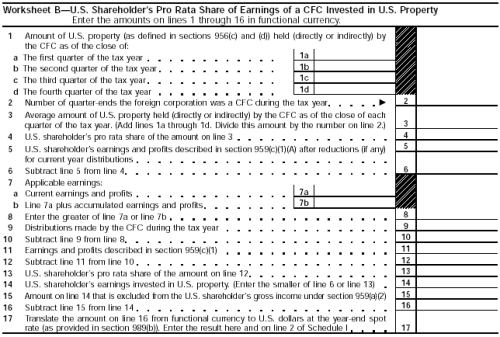
Worksheet
B
Line 28. Exclusion of U.S. income.
Subpart F income does not include any U.S. source income (which,
for these purposes, includes all carrying charges and all interest,
dividends, royalties, and other investment income received or accrued
by a FSC) that is effectively connected with a CFC's conduct of a
trade or business in the United States unless that item is exempt from
taxation (or is subject to a reduced rate of tax) pursuant to a treaty
obligation of the United States.
Line 31. Current E&P.
A CFC's subpart F income is limited to its current year E&P,
computed under the special rule of section 952(c)(3). The amount
included in the gross income of a U.S. shareholder of a CFC under
section 951(a)(1)(A)(i) for any tax year and attributable to a
qualified activity must be reduced by the shareholder's pro rata share
of any qualified deficit (see section 952(c)(1)(B)).
Certain current year deficits of a member of the same chain of
corporations may be considered in determining subpart F income. See
section 952(c)(1)(C).
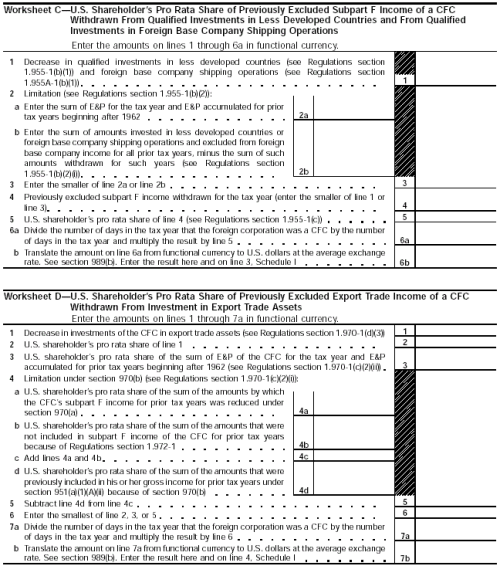
Worksheets
C
Worksheet B
Use Worksheet B above to determine a U.S. shareholder's pro rata
share of earnings of a CFC invested in U.S. property that is subject
to tax. Only earnings of a CFC not distributed or otherwise previously
taxed are subject to these rules. Thus, the amount of previously
untaxed earnings limits the section 956 inclusion. A CFC's
investment in U.S. property in excess of this limit will not be
included in the taxable income of the CFC's U.S. shareholders.
Further, U.S. shareholders are only taxed on earnings invested in
U.S. property to the extent the investments exceed the CFC's
previously taxed earnings. The balances in the previously
taxed accounts of prior section 956 inclusions (see section
959(c)(1)(A)) and current or prior subpart F inclusions (see section
959(c)(2)) reduce what would otherwise be the current section 956
inclusion.
Note:
The previously taxed accounts should be adjusted to reflect any
reclassification of subpart F inclusions that reduced prior section
956 or 956A inclusions (see section 959(a)(2), and Schedule J).
Distributions are also taken into account before the section 956
inclusion is determined. Distributions generally are treated as coming
first from (and thus reducing the balances of) the previously taxed
accounts. Thus, the U.S. shareholders must:
- Compute the current subpart F inclusion (potentially
increasing that previously taxed account);
- Take into account current distributions (potentially
reducing the previously taxed and untaxed accounts); and
- Compute the current section 956 inclusion (potentially
increasing or reclassifying the previously taxed accounts).
U.S. property is measured on a quarterly average basis.
For purposes of this worksheet, the amount taken into account with
respect to U.S. property is its adjusted basis for earnings and
profits purposes, reduced by any liability the property is subject to.
See sections 956(c) and (d) for the definition of U.S. property. The
amount of U.S. property held (directly or indirectly) by the CFC does
not include any item that was acquired by the foreign corporation
before it became a CFC, except for the property acquired before the
foreign corporation became a CFC that exceeds the applicable earnings
(as defined in section 956(b)) accumulated during periods before it
became a CFC.
If the foreign corporation ceases to be a CFC during the
tax year:
- The determination of the U.S. shareholder's pro rata share
will be made based upon the stock owned (within the meaning of section
958(a)) by the U.S. shareholder on the last day during the tax year in
which the foreign corporation was a CFC;
- The CFC's U.S. property for the taxable year will be
determined only by taking into account quarters ending on or before
such last day (and investments in U.S. property as of the close of
subsequent quarters should be recorded as zero on line 1); and
- In determining applicable earnings, current earnings and
profits will include only earnings and profits that are allocable (on
a pro rata basis) to the part of the year during which the foreign
corporation was a CFC.
Schedule J
Use Schedule J to report accumulated E&P, in functional
currency, computed under sections 964(a) and 986(b).
Column (a)
Use column (a) to report the opening balance, current year
additions and subtractions, and the closing balance in the foreign
corporation's post-1986 undistributed earnings pool.
Note:
Line 3 (E&P as of the close of the tax year, before actual or
deemed distributions during the year) is the denominator of the
deemed-paid credit fraction under section 902(c)(1) used for foreign
tax credit purposes.
Column (b)
Use column (b) to report the aggregate amount of the foreign
corporation's pre-1987 section 964(a) E&P accumulated since 1962
and not previously distributed or deemed distributed. These amounts
are figured in U.S. dollars using the rules of Regulations sections
1.964-1(a) through (e), translated into the foreign corporation's
functional currency according to Notice 88-70, 1988-2 C.B. 369.
Column (c)
Use column (c) to report the running balance of the foreign
corporation's previously taxed earnings and profits (PTI), or section
964(a) E&P accumulated since 1962 that have resulted in deemed
inclusions under subpart F. Pre-1987 U.S. dollar PTI should be
translated into the foreign corporation's functional currency using
the rules of Notice 88-70 and added to post-1986 amounts in the
appropriate PTI category.
- Include in column (c)(i) PTI attributable to, or
reclassified as, investments in U.S. property (section 959(c)(1)(A)
amounts).
- Include in column c(ii) PTI attributable to, or reclassified
as, earnings invested in excess passive assets (section 959(c)(1)(B)
amounts) accumulated in tax years of foreign corporations beginning
after September 30, 1993, and before January 1, 1997.
- Include in column (c)(iii) PTI attributable to subpart F
income net of any reclassifications (section 959(c)(2)
amounts).
Column (d)
Use column (d) to report the opening and closing balance of the
foreign corporation's accumulated E&P. This amount is the sum of
post-1986 undistributed earnings, pre-1987 section 964(a) E&P not
previously taxed, and PTI.
Schedule M
Important:
In translating the amounts from functional currency to U.S.
dollars, use the average exchange rate for the foreign corporation's
tax year. See section 989(b).
Every U.S. person described in Category 4 must file Schedule M to
report the transactions of the foreign corporation's annual accounting
period ending with or within the U.S. person's tax year.
If a U.S. corporation that owns stock in a foreign corporation is a
member of a consolidated group, list the common parent as the U.S.
person filing Schedule M.
Lines 6 and 16.
Report on these lines dividends received and paid by the foreign
corporation not previously taxed under subpart F in the current year
or in any prior year.
Lines 19 and 20.
Report on lines 19 and 20 the largest outstanding balances during
the year of gross amounts borrowed from, and gross amounts loaned to,
the related parties described in columns (b) through (f). Do not enter
aggregrate cash flows, year-end loan balances, average balances, or
net balances. Do not include open account balances resulting from
sales and purchases reported under other items listed on Schedule M
that arise and are collected in full in the ordinary course of
business.
Schedule N
Important:
In computing a shareholder's taxable income, actual dividends are
translated into U.S. dollars at the spot rate on the date the dividend
is included in income. Deemed inclusions of undistributed foreign
personal holding company income are translated into U.S. dollars at
the average exchange rate for the foreign corporation's tax year. See
section 989(b).
Every U.S. citizen or resident described in Category 1 must file
Schedule N to report the activities of a foreign personal holding
company. See page 1 for the definition of a foreign personal holding
company. The information is submitted for the company's annual
accounting period that ends with or within the officer's, director's,
or shareholder's tax year.
The determination of whether an individual is a Category 1 file is
made on the date Form 5471 is required to be filed. If no individual
qualifies as of that date, the determination is made on the last day
of the foreign corporation's tax year in which there was such a person
who was a U.S. citizen or resident.
If the corporation ceased to be a foreign personal holding company
during the tax year or after the tax year ended, you must still file
Schedule N if the corporation was a foreign personal holding company
at any time during the tax year.
First-time filer.
If this is the first time you are submitting information required
under section 6035, attach the following.
- A statement of stock ownership showing that during the
corporation's tax year more than 50% in value of its outstanding stock
was owned, directly or indirectly, by or for not more than five
individual citizens or residents of the United States.
- A detailed statement of the conversion privileges of any
outstanding securities that are convertible to the corporation's
stock.
- A detailed statement of the respective rights of the various
classes of shareholders if more than one class of stock is
outstanding.
Exception.
This information does not need to be submitted if it was previously
furnished by another person.
Part I - Shareholder Information
Section A
List the following:
- The foreign personal holding company's outstanding
securities that are convertible into its stock,
- The interest rate and the face value of the securities at
the beginning and end of the corporation's annual accounting period,
and
- Any options granted by the corporation during its tax
year.
Section B
List the following:
- The identify of each person (name and address) who is the
holder of convertible securities in the foreign personal holding
company or who is granted an option for the corporation's stock,
- The class of securities held and the number and face value
of the securities at the beginning and end of the corporation's tax
year, and
- An explanation of any change in the holdings for each person
holding the convertible securities.
Part II - Income Information
Section A
Line 4. Adjustments to taxable income or (loss).
Line 4a.
Enter the difference between the taxes deducted in computing
taxable income and the taxes allowable under section 556(b)(1) in
computing undistributed foreign personal holding company income.
Attach the following.
- A schedule showing the nature of income on which Federal
income tax was paid or withheld at the source; when and where the tax
was paid or withheld; the amount of tax paid or accrued; and the tax
year to which the tax relates.
- A schedule of income, war profits, and excess profits taxes
of foreign countries and U.S. possessions accrued during the tax year
not allowable as a deduction because a foreign tax credit was
claimed.
Line 4b.
Enter the difference between the charitable contributions deducted
in computing taxable income and the charitable contributions allowable
under section 556(b)(2) in computing undistributed foreign personal
holding company income. See section 556(b)(2) and the related
regulations.
The carryover of charitable contributions made in a prior year is
not allowed as a deduction in computing undistributed foreign personal
holding company income for any tax year.
Line 4c.
The special deductions described in section 556(b)(3) are not
allowed in computing undistributed foreign personal holding company
income. Therefore, they must be added back to taxable income in
computing undistributed foreign personal holding company income.
Enter these amounts on line 4c as a positive number.
Line 4d.
Refigure the net operating loss (as defined in section 172(c)) for
the preceding tax year computed without the deductions provided in
sections 241 through 247, 249, and 250. Enter on line 4d the
difference between this amount and the net operating loss deduction
allowed in computing taxable income.
Line 4e.
Enter the total expenses limited by section 556(b)(5) as a positive
number. In computing undistributed foreign personal holding company
income, section 556(b)(5) limits the allowance of deductions for trade
or business expenses and depreciation that are allocable to the
operation and maintenance of the property owned or operated by a
foreign personal holding company. These deductions will not be allowed
in excess of the aggregate amount of the rent or other compensation
received for the use of, or the right to use, the property unless it
is established to the satisfaction of the IRS that:
- The rent or other compensation received was the highest
obtained or, if none was received, that none was obtainable;
- The property was held in the course of a business carried on
for profit; and
- Either there was reasonable expectation that the operation
of the property would result in a profit or the property was necessary
to the conduct of the business.
If excess deductions are claimed, attach a statement for each
property showing the following:
- A description of the property;
- The cost or other basis to the corporation and the nature
and value of the consideration paid for the property;
- The name and address of the person from whom the property
was acquired and the date the property was acquired;
- The name and address of the person to whom the property was
leased or rented, or the person permitted to use the property, and the
number of shares of stock, if any, held by the person and the members
of his or her family; and
- The nature (cash, securities, services, etc.) and the gross
amount of rent or other compensation received or accrued for the use
of, or the right to use, the property during the tax year and for each
of the 5 preceding years and the amount of expense incurred for, and
the depreciation sustained on, the property for such years.
Also include the following:
- Evidence that the rent or other compensation was the highest
obtainable or, if none was received or accrued, a statement of the
reason that none was received or accrued;
- A copy of the contract, lease, or rental agreement;
- The purpose for which the property was used;
- The business carried on by the corporation for which the
property was held and the gross income, expenses, and taxable income
from the conduct of that business for the tax year and for each of the
5 preceding years;
- The reasons for acquiring the property, for expecting that
it would be profitable, and for using the property in the business of
the corporation; and
- Any other information to support the deductions.
Line 4f.
Enter the total of any deductions taken in computing taxable income
relating to taxes of a shareholder paid by the corporation (section
164(e)), and pensions, trusts, etc. (section 404).
Line 8. Deduction allowed for dividends paid after close of tax year.
Enter all dividends paid after the close of the tax year and on or
before the 15th day of the 3rd month following the close of the year
if the foreign personal holding company designated such dividends as
taken into account under section 563(c).
Note:
This amount may not exceed the amount entered on line 7. See
section 563(c) for additional information.
Section B
The deduction for dividends paid is the sum of the dividends paid
during the tax year and the consent dividends for the tax year
(determined under section 565). See sections 561 and 562.
Attach the following:
- A copy of each dividend resolution and
- A concise statement of the pertinent facts relating to the
payment of each dividend, clearly specifying:
- The medium of payment;
- If not paid in money, the fair market value and adjusted
basis (or face value, if paid in the corporation's own obligations) on
the date of distribution of the property; and
- The manner in which the fair market value and adjusted basis
were determined.
Schedule O
Schedule O is used to report the organization or reorganization of
a foreign corporation and the acquisition or disposition of its stock.
Every U.S. citizen or resident described in Category 2 must
complete Part I. Every U.S. person described in Category 3 must
complete Part II.
See Regulations section 1.6046-1(i) for rules on determining when
U.S. persons constructively own stock of a foreign corporation and
therefore are subject to the section 6046 filing requirements.
Part I
Column (d).
Enter the date the shareholder first acquired 10% or more (in value
or voting power) of the outstanding stock of the foreign corporation.
Column (e).
Enter the date the shareholder acquired (whether in one or more
transactions) an additional 10% or more (in value or voting power) of
the outstanding stock of the foreign corporation.
Part II Section C - Acquisition of Stock
Section C is completed by shareholders who are completing Schedule
O because they have acquired sufficient stock in a foreign
corporation. If the shareholder acquired the stock in more than one
transaction, use a separate line to report each transaction.
Column (d).
Enter the method of acquisition (e.g., purchase, gift, bequest,
trade, etc.).
Column (e)(2).
Enter the number of shares acquired indirectly (within the meaning
of section 958(a)(2)) by the shareholder listed in column (a).
Column (e)(3).
Enter the number of shares constructively owned (within the meaning
of section 958(b)) by the shareholder listed in column (a).
Section D - Disposition of Stock
Section D must be completed by shareholders who dispose of their
interest (in whole or in part) in a foreign corporation.
Column (d).
Enter the method of disposition (e.g., sale, bequest, gift, trade).
Example.
In 1993, Mr. Jackson, a U.S. citizen, purchased 10,000 shares of
common stock of foreign corporation X. The purchase represented 10%
ownership of the foreign corporation.
On July 1, 2000, Mr. Jackson made a gift of 5,000 shares of foreign
corporation X to his son, John. Because Mr. Jackson has reduced his
holding in the foreign corporation, he is required to complete Form
5471 and Schedule O. To show the required information about the
disposition, Mr. Jackson completes Section D as follows:
- Enters his name in column (a).
- Enters common in column (b).
- Enters July 1, 2000, in column (c).
- Enters gift in column (d).
- Enters 5,000 in column (e)(1).
- Enters -0- in column (f) because the disposition was
by gift.
- Enters the name and address of his son, John, in column
(g).
Section F
Example for Item (c)
Mr. Lyons acquires a 10% ownership in foreign corporation F. F is
the 100% owner of two foreign corporations, FI and FJ. F is also a 50%
owner of foreign corporation FK. In addition, F is 90% owned by
foreign corporation W.
Mr. Lyons completes and files Form 5471 and Schedule O for the
corporations in which he is a 10% or more shareholder. Mr. Lyons is
also required to submit a schedule if the foreign corporation is a
member of a chain of corporations, and to indicate if he is a 10% or
more shareholder in any of those corporations.
Mr. Lyons would prepare a list showing the corporations as follows:
- Corporation W
- Corporation F
- Corporation FI
- Corporation FJ
- Corporation FK
Then Mr. Lyons is required to indicate that he is a 10% or more
shareholder in corporations F, FI, FJ, and FK.
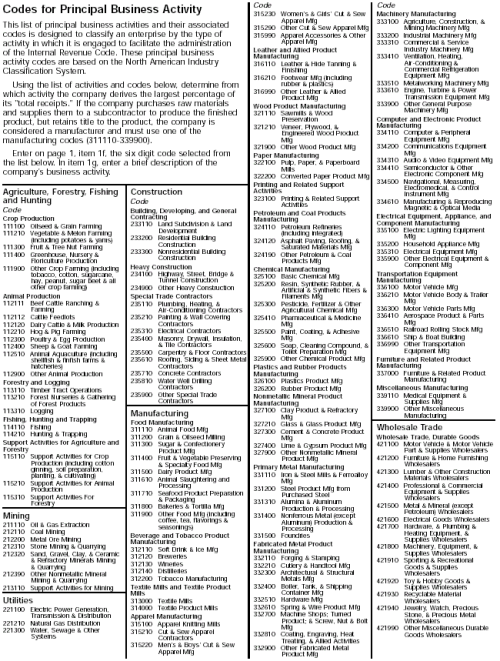
Codes for
Principal Business Activity
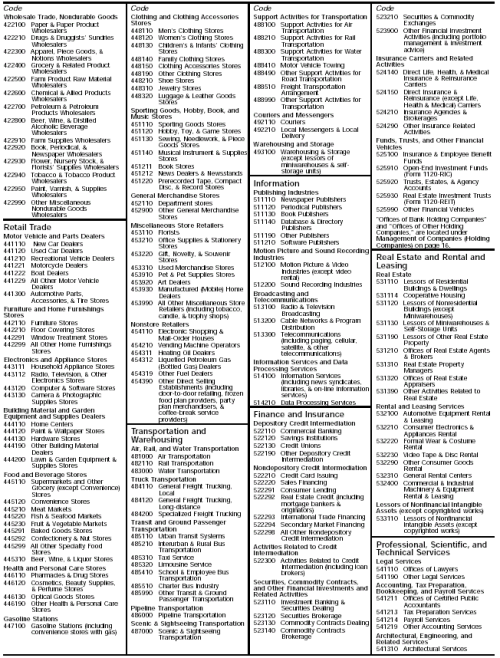
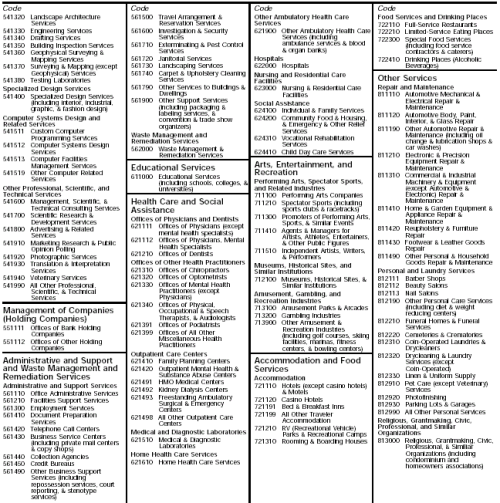
Previous | First
Instructions Index | 2002 Tax Help Archives | Tax Help Archives | Home
